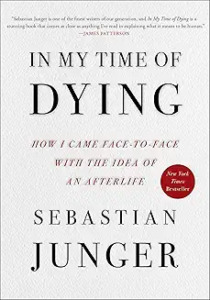In My Time of Dying: How I Came Face-To-Face with the Idea of an Afterlife by Sebastian Junger 2024
Junger was a 55 year old successful writer, father of two small daughters, and living the life when he came perilously close to dying with no warning or time for preparation.
He had had some sharp abdominal pains in the past, but they had disappeared quickly and completely. Not the episode in July of 2020. The pain was overwhelming, but despite resolving under the watchful eyes of the EMT’s who his wife had called, she demanded that they take him to Cape Cod Hospital, one hour away. That saved his life. By the time he was wheeled into the Emergency Department, he was in shock from an abdominal hemorrhage and perilously close to dying. He felt himself separating from his body, floating overhead and being urged into a black abyss by his father who had died years earlier—all of this while surgeons, ER doctors, radiologists, and anesthesiologists worked frantically to locate the source of the bleeding while replacing the huge volume of blood loss and maintaining coagulability. In a near photo finish, they found the aneurysm in a small pancreatic artery, managed to catheterize and embolize it, and saved his life.
The book is really two books in one. In the first, Junger relates several near death incidents he experienced earlier in his life—reporting on the war in Libya, surfing in a winter storm in the Atlantic, bicycling in Boston—before this one, THE BIG ONE. He describes the resuscitation, surgery, and post op course in excruciating detail (I’m not sure I needed to know what kind of a catheter had been threaded into his jugular vein.) in the first book.
In the second, he explores theories of the afterlife, starting with the literature on Near Death Experiences (NDE’s) and finishing with a pretty darn good summary of quantum mechanics (despite Richard Feynmann’s famous quote that “If you think you understand quantum mechanics, you don’t understand quantum mechanics.”) and tossing theories of the metaverse, reality, consciousness, and entanglement in the middle.
The book is well written and hangs together nicely, but I remain skeptical about the ‘death bed’ conversions of so many writers to a belief in an afterlife. I’ve read several of these including Oliver Sacks’ “Gratitude”, Paul Kalanithi’s “When Breath Becomes Air”, and Christopher Hitchens’ “…and yet” and I’m struck by the need of these brilliant writers and physicians to speculate on what follows the act of dying. As Junger writes, “Dying is the most ordinary thing you will ever do, but also the most radical”. Every one of the billions of human beings who have ever been on the planet, including yours truly, have died or will do so one day in the future. A favorite essayist/poet Thomas Lynch has written that ‘the odds of dying remain perilously close to 100%’ and he should know. His day job is being a mortician.
We all die, some with weeks or months of preparation like Kalanithi, Sacks, and Hitchens, some struck down with no warning, and some who approach the line between life and death or even cross over briefly in a NDE, but survive to describe it. Nobody has ever died, stayed dead, and related to the rest of us what it’s like. Do our ‘souls’ join a universal consciousness that pervades the universe or are we gone, finished, done the dust to dust routine when our brain stops electrical activity? Nobody knows but credit Junger with a fine attempt to explore the question.



